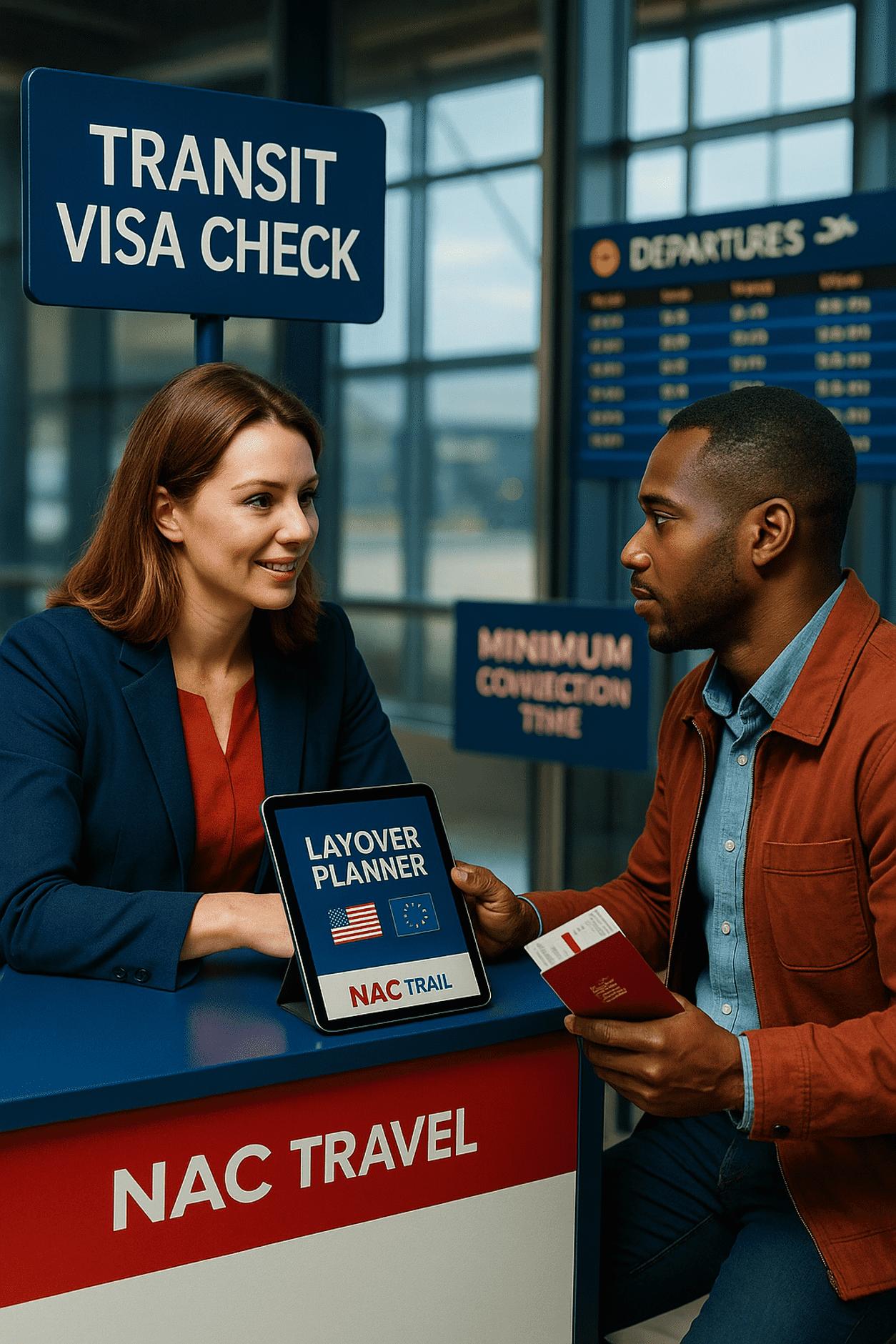Missed connections and surprise visa rules are the two quickest ways to spoil a trip. Here is a clear, practical guide to judging connection times, spotting transit-visa traps, and building a plan that actually works. At the end you will see how NAC Travel International turns these rules into a smooth itinerary.
The three questions that decide everything
-
Are your flights on one ticket or on separate tickets?
One ticket usually means a protected connection that respects the airport’s Minimum Connection Time. Separate tickets often mean you must exit airside, collect bags, and recheck. That can trigger a transit visa and needs a much longer buffer. -
Do you stay airside or do you need to enter the country?
Staying airside usually avoids immigration. Needing to collect luggage, switch terminals that sit landside, change airports, or stay overnight often forces an entry. Entry can require a visa depending on your passport. -
What is the airport layout and operating reality?
Some hubs are single terminal and fast. Others have long walks, bus gates, or train transfers. Night curfews, winter weather, and tight security can add minutes you did not plan for.
Minimum Connection Time made simple
Minimum Connection Time (MCT) is the shortest legal time the airport and airlines allow for a valid connection. Treat it as the floor, not the target.
-
Same ticket: if the system sells you the connection, it met MCT. Delays are usually protected with rebooking.
-
Separate tickets: MCT no longer protects you. Add generous buffers and check if you must go landside.
Rules of thumb for a stress-free plan
-
Domestic to domestic: aim for 60 to 90 minutes.
-
Domestic to international: aim for 90 to 120 minutes.
-
International to international: aim for 2 hours at compact hubs and 2.5 to 3 hours at complex hubs.
-
International to domestic: plan 2.5 to 3 hours for immigration, baggage claim, customs, and security, more if terminals are far apart.
These are guidelines. If you need to change airports, switch between non-connected terminals, or recheck bags, add even more time.
When a transit visa might be required
You may need a transit visa if any of the following apply:
-
Your nationality requires an airside transit visa at a specific country or airport.
-
You must enter the country to recheck luggage or change airports.
-
You have an overnight layover without 24-hour airside facilities.
-
You are traveling on separate tickets and the onward airline requires landside check-in.
-
Your route includes a domestic connection inside the country of transit. Domestic legs usually require entry first.
Always verify requirements for your passport and exact routing before you book non-refundable items.
Red flags that deserve extra buffer
-
Last flight of the day on the second leg
-
Winter operations or storm season
-
Bus gates, remote stands, or terminal trains
-
Checked bags on separate tickets
-
Families with young kids, mobility needs, or pets
-
Airports known for long security or immigration queues
Build your own layover buffer in five steps
-
Find the airport MCT for your connection type.
-
Add operational time for security, terminal transfer, or immigration.
-
Add a delay cushion that matches the season and the route’s on-time history.
-
Plan a recovery option such as a later backup flight or flexible fare.
-
Check transit-visa rules for your passport and routing before you pay.
How NAC Travel International helps
Transit-visa checks by passport and route
We confirm whether your connection is airside or landside, check visa rules for your nationality, and advise on the safest airports for your path.
Buffer design that respects reality
We analyze airport layouts, typical queues, and weather history, then build connection times that work in practice, not just on paper.
Protected connections first
Where possible we book single-ticket itineraries so missed connections trigger automatic rebooking. If separate tickets save money, we add the right layover time and instructions to keep you safe.
Baggage and terminal strategy
We plan through-check options, avoid risky airport changes, and schedule meets or lounge access when long waits are unavoidable.
Plan B playbook
You get a simple fall-back sheet: who to talk to, what to say, and which later flights are realistic if delay hits.
Quick checklist before you buy
-
One ticket or two
-
Airside all the way or landside at any point
-
MCT plus your own safety buffer
-
Transit-visa requirement for your passport
-
Overnight rules and airport opening hours
-
Backup flight identified
Answer those cleanly and your layover is very likely long enough. If you want a second set of eyes, NAC Travel International will measure the connection, confirm visa rules, and book the version that gets you there without drama.
